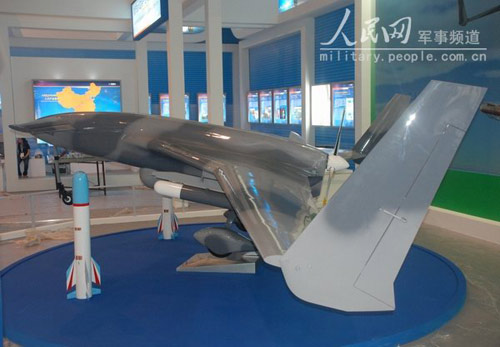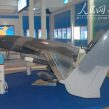
Advances in China’s UCAV Program
Publication: China Brief Volume: 10 Issue: 19
By:

The acquisition of advanced foreign technologies coupled with sustained high rates of investment in its defense industries has helped accelerate the pace and scope of China’s military modernization in recent years. One military platform that apparently benefited from this substantial investment, which has the potential to alter the future battlefield, is China’s unmanned combat aerial vehicles (UCAV) program. The attendant technologies associated with the development of an unmanned aerial system capable of combat reflect more than just the hardware required to build the aircraft. The integration of a C4I (Command, Control, Communications, Computing and Intelligence) structure is a necessary component for operating an effective unmanned aerial system. An integrated UCAV system could greatly enhance the Chinese military’s capability to track, identify and strike targets in its increasingly complex land, and possibly near-and far-seas missions (China Review News, June 17).
In recent years, China has been actively scouting, purchasing and developing technologies to support its indigenous U(C)AV program. For now, Chinese manufacturers are still playing catch up in the industry dominated by U.S. and European manufacturers. The development of China’s indigenous unmanned systems faced many challenges, particularly in terms of developing more secure and resistant control and communication links (Sina.com.cn, February 8, 2007). The advancement of its indigenous U(C)AV program still requires foreign technologies. For instance, China has tried to acquire from the South African defense company Denel the TV video cameras and second-generation thermal imaging cameras used in its Seeker II UAV surveillance system (UPI, January 13, 2009).
Reports also indicate that China may have already begun to sell its systems to countries in Southeast Asia. According to Malaysia’s Kuala Lumpur Security Review, the Chinese defense companies at the Brunei International Defense Exhibition 2009 (BRIDEX 2009) featured the Chang Hong-3 (CH-3) UCAV platform, ostensibly to sell to countries like Brunei and Cambodia. The CH-3 was also a highlight at the 12th annual Defense Services Asia (DSA)-2010 exhibition, which was held in Malaysia from April 19-22. These developments suggest that China’s indigenous UCAV program has made a significant stride in recent years.
It is also worth noting that the medium-altitude long-endurance (MALE) UCAV model was first unveiled at the 2008 Zhuhai Airshow, only a year before BRIDEX 2009, and some industry analysts at the time believed that the CH-3 model was still far from becoming a reality. Others also claim that the CH-3 is based off the Yabhon-R, which is a system jointly developed by Malaysia and the UAE. There are now reports indicating that the Chinese may unveil a "CH-4" model at the upcoming biannual Zhuhai Airshow, which will be held from November 16-21 in Guangdong (Wen Wei Po [Hong Kong], July 15; China Times [Taiwan], July 1; Jizhe.cc, July 1; Airshow.com.cn).
Developed by the China Aerospace Science and Technology Corporations’ 11th Academy, the CH-3 has a wingspan of 8 meters, body length of 5.5 meters, takeoff weight of 640 kilograms, a payload of 60 kilograms, maximum load 100 kilograms, and can carry opto-electronic reconnaissance equipment and reportedly two AR-1-type air to ground missiles (Sinodefenceforum.com). According to military specialists, the new 45-Kg AR-1 is a laser-guided missile that is similar in capability to the U.S. Predator-1 (Military.com, April 9, 2009).
The expansion of China’s military satellite network could also enable the use of high-altitude U(C)AVs over long ranges and in operations farther from shore (See "PLA Expands Network of Military Reconnaissance Satellites," China Brief, August 19). While the Chinese military has only limited experience with unmanned aerial systems to date, the practical application of UAV sensor information to battlefield operations is clearly moving beyond the developmental stage. Indeed, according to sources cited by China News Agency from the third annual China UAVs Expo, China’s unmanned aerial vehicles (e.g. W-50 pilotless aircraft) already entered into active service with PLA units and have attained "combat effectiveness" (China Daily, June 11; China Review News, June 17).
China’s development of unmanned aerial systems was also prominently displayed during the 60th anniversary celebration of the People’s Republic of China (PRC) on October 1, 2009. The Chinese press raved about how 52 types of "new weapon systems" were showcased in 30 vehicle and 12 air formations during the military parade portion of the 60th anniversary celebration (PLA Daily, September 17, 2009). According to Professor Tan Kaijia, a weaponry expert at the PLA’s National Defense University, "The official debut of the PLA’s UAVs reveals that China has made substantial progress in intelligent control system, precise measuring-controlling system and computer information processing for military uses." "The acquisition of a large amount of UAVs will greatly speed up information collecting procedures in battlefield environment and improve the troops’ quick-response ability," Tan said (Xinhua News Agency, October 1, 2009).
In the final analysis, as China acquires new technologies, the application of unmanned aerial systems in the PLA’s tactical C4I operations is likely to increase. While these developments only represent a small step in that direction, the growing range of capabilities embodied within a sophisticated UCAV system could potentially alter the Chinese calculus of forces required for sea control and land attack in scenarios ranging from the South and East China Sea. Furthermore, as China’s explorations for new technologies yield more information that it can convert for its own technological purposes, the PLA could exploit existing and developing technology to leap in the development of a varied UCAV system to support its evolving anti-access/area denial strategy.





